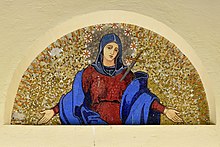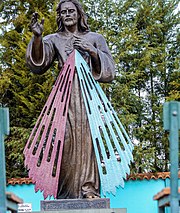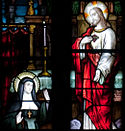
A Marian apparition is a reported supernatural appearance by Mary the mother of Jesus, or a series of related such appearances during a period of time.

The First Saturdays Devotion, also called the Act of Reparation to the Immaculate Heart of the Blessed Virgin Mary, is a Catholic devotion which, according to Sister Lúcia of Fátima, was requested by the Virgin Mary in an apparition at Pontevedra, Spain, in December 1925.

Our Lady of Sorrows, Our Lady of Dolours, the Sorrowful Mother or Mother of Sorrows, and Our Lady of Piety, Our Lady of the Seven Sorrows or Our Lady of the Seven Dolours are names by which Mary, mother of Jesus, is referred to in relation to sorrows in life. As Mater Dolorosa, it is also a key subject for Marian art in the Catholic Church.
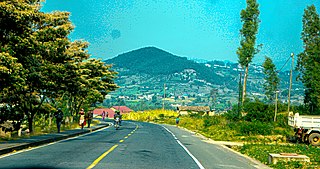
Kibeho is a sector and small town in south Rwanda, which became known outside of that country because of reported apparitions of the Blessed Virgin Mary and Jesus Christ occurring between 1981 and 1989. It is also known for the Kibeho Massacre in April 1995, when several thousand internally displaced people were killed by the Rwandan Patriotic Army.

The Catholic Church in Rwanda is part of the worldwide Catholic Church.

Immaculée Ilibagiza is a Rwandan American author and motivational speaker. Her first book, Left to Tell: Discovering God Amidst the Rwandan Holocaust (2006), is an autobiographical work detailing how she survived during the Rwandan genocide. She was featured on one of Wayne Dyer's PBS programs, and also on a December 3, 2006, segment of 60 Minutes.
Veronica Lueken was a Roman Catholic housewife from Bayside, New York, who, between 1970 until her death in 1995, reported experiencing apparitions of the Virgin Mary, Jesus, and numerous Catholic saints.
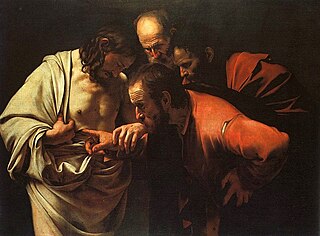
A number of people have claimed to have had visions of Jesus Christ and personal conversations with him. Some people make similar claims regarding his mother, Mary. Discussions about the authenticity of these visions have often invited controversy. The Catholic Church endorses a fraction of these claims, and various visionaries it accepts have achieved beatification, or even sainthood.

Mary, the mother of Jesus in Christianity, is known by many different titles, epithets, invocations, and several names associated with places.
The Roman Catholic Diocese of Gikongoro is a diocese located in the city of Gikongoro in the ecclesiastical province of Kigali in Rwanda. The diocese is home to the parish of Kibeho, where there were reported apparitions of the Virgin Mary throughout the 1980s. A shrine celebrating the apparitions of Our Lady of Kibeho now stands at the site and serves as a place of pilgrimage. The diocese also includes large Catholic parishes at Kaduha and Cyanika. Gikongoro was historically the poorest province in Rwanda. Gikongoro is now part of South Province.
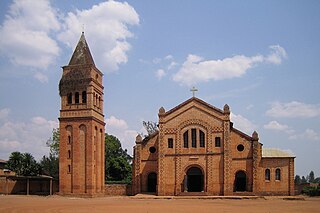
Christianity is the largest religion in Rwanda. The most recent national census from 2012 indicates that: 43.7% of Rwanda's population is Catholic, 37.7% is Protestant, 11.8% is Seventh-day Adventist, 2.0% is Muslim, 2.5% claims no religious affiliation, and 0.7% is Jehovah's Witness.
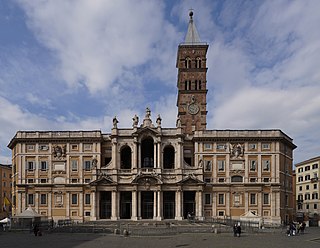
Catholic Marian churches are religious buildings dedicated to the veneration of the Blessed Virgin Mary. These churches were built throughout the history of the Catholic Church, and today they can be found on every continent including Antarctica. The history of Marian church architecture tells the unfolding story of the development of Catholic Mariology.

The Lady of All Nations is a Catholic Marian title sometimes associated with apparitions of the Blessed Virgin Mary to Ida Peerdeman of Amsterdam, Netherlands. Peerdeman claimed to have received 56 visions of the Lady from 1945 to 1959.

The Chaplet of the Seven Sorrows, also known as the Rosary of the Seven Sorrows or the Servite Rosary, is a Rosary based prayer that originated with the Servite Order. It is often said in connection with the Seven Dolours of Mary.
Augustin Misago was the Roman Catholic bishop of the Diocese of Gikongoro, Rwanda.
The Benebikira Sisters are a Roman Catholic religious institute of women founded in Rwanda in the early 1900s. Their Charisma is to evangelize by example. They do this by their diverse works of service, carried out with joy and love. Their mission is education, particularly for girls, care of the sick and the poor, especially women and children. Their spirituality is based on the Jesuit model of contemplation in action, seeing God in all things. However the expression of their Catholic faith and consecrated spirituality is formed by their Rwandan culture. The Benebikira are one with their people, sharing their Christian faith that calls them to be a people of hope and a voice for justice and love. Numbering almost 400 sisters, they have 55 communities located primarily in Rwanda but also in Burundi, Uganda, Congo, Kenya, and Rome. Their Kinyarwanda name means “Daughters of Mary” in English.

Mary Cecilia of Jesus, OCD, born as Natividad Zialcita, was a Discalced Carmelite nun and prioress of the monastery in Lipa during the time apparitions of Our Lady Mediatrix of All Graces in 1948. She was also the confidante of the visionary postulant, Teresita Castillo.
